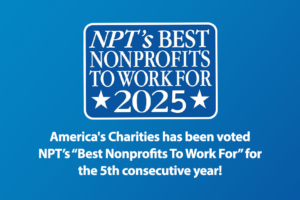Ronita Mohan of Venngage and Lindsay J.K. Nichols of America's Charities | October 15, 2020
Fundraising During a Crisis: What Nonprofits Can Do
Fundraising during a crisis is a challenge—donors want to be careful with their money, but they also want to continue supporting their favorite nonprofits.
Here are six tips for fundraising during these difficult times—you can use these tips to spread awareness and bring in some income.
1. Be Transparent
The world has changed because of the COVID-19 (coronavirus) pandemic—and nonprofits have been impacted as a result. It can feel uncomfortable to share this information with your donors, but transparency is usually the best policy. Donors have also been impacted by the pandemic, and they need to understand the wide-reaching implications on their favorite causes.
If you’re having to close down programs, change internal structures, and feel the future is uncertain, you can let your donors know through your visual communications.
Especially describe if COVID-19 has implications on the way your organization functions in the longer-term. Donors want to know what will happen with the money they donate.
For instance, if fundraising events are canceled or moved online, think about emailing or mailing your donors information explaining why, like the example below.

We know a consequence of canceled events is likely to impact your budget. Yet your services are still needed, so describe the funding gap you’re having without your typical events.
And as always, when asking for donations, it’s best to outline the problem your organization addresses, and how donors — and their donations — can be part of the solution.
Being specific about your needs can ease donor concerns—remember, they are invested in your organization’s future. They donate to you because they believe in your efforts and mission.
By being honest and transparent, you encourage supporters to continue helping you and ensure the continuity of your organization.
2. Focus on Workplace Giving
Workplace giving programs are employer-hosted programs that empower people to donate to their favorite charities.
While these programs used to be focused on paper pledge forms, advancements in technology give donors multiple ways to donate to charities of their choice.
And because workplace giving is typically focused on payroll giving – where a little bit of money is taken from a donor’s paycheck all year long – it can provide a steady revenue stream for nonprofits.
In fact, many workplace giving programs start at a time of crisis. For example, many companies are holding COVID-19 campaigns to empower their employees to support their favorite causes.
But in fact, payroll giving means nonprofits can rely on that sustainable funding all year long, making it easier to plan and budget accordingly. And because the revenue generated is often unrestricted, nonprofits can use donations where and when they need it most.
Nonprofits that focus on their corporate partners, and the employees of those organizations, are rewarded with larger investments, over a longer period of time. Charities can also apply to participate in government programs – whether it’s the federal Combined Federal Campaign, or state or local government campaigns – the nonprofits that tend to diversify their revenue to include workplace giving fare better in the long run.
On the employer side, there are numerous methods to encourage workplace giving. Organizations can offer to match donations from employees, offer volunteering grants, or paid time off to volunteer.
These programs are a great way to improve employee engagement—with more workplaces going remote due to the pandemic, giving programs help bring employees together.
Remote working makes watercooler meetups and conversations near-impossible—creating connections between fellow employees becomes a huge challenge, as a result.
Volunteering and giving programs give employee donors the feeling of being connected to their colleagues and their company through their donations to charitable causes.
When fundraising becomes a challenge, workplace giving can be a powerful tool to stabilize – and increase – income and create social impact.
3. Online Auctions
There are numerous ways to use the online world for fundraising—one of the more appealing methods is the online auction.
Several resources are now available—such as AccelEvents, GoGharity, or QGiv—that give nonprofits the ability to run online auctions.
These can be silent auctions, where organizations list out items in advance and ask buyers to submit their bids via mobile apps or websites. The highest bidder wins the item.
You can also hold a live auction online via Facebook, YouTube, or Instagram for increased engagement.
Online auctions have wider appeal and aren’t constrained by location or space, giving nonprofits the ability to reach supporters they may not have been able to otherwise.
Sending items to auction bidders need not be handled in-house—there are numerous shipping options aimed at businesses and nonprofits.
4. Contests and Competitions
For-profit businesses often run contests online to gain new followers, boost engagement on their channels, and to market their products.
Nonprofits can take a leaf out of their book and hold contests and competitions online to attract supporters for their fundraising efforts.
People love contests—they are fun and easy to share, which makes them attractive.
The online sphere has made it easier to create numerous competitions that appeal to a wide range of audiences.
Social media is great for holding contests, but you can also run them on your website.
Competitions like sweepstakes, user-generated contests, hashtag competitions, polls, and referrals can be run without too much effort.
But you can also have more elaborate contests like talent nights and online quizzes that are held live.
The fundraising aspect of these contests comes through the fees you charge for entering—or you can ask people to donate an amount of their choice to participate.
Despite the appeal of competitions serving as prizes themselves, nonprofits don’t need to break the bank to reward their winners.
Simple prizes such as branded mugs, calendars, or branded and custom t-shirts make for fun prizes that people will enjoy having in their homes.
5. Empower Communities
How do you drive donations when supporters are being careful with their money? By bringing in the whole community, not just the individual.
Peer-to-peer fundraising for your nonprofit is a great way to boost awareness about your organization.
You can ask your supporters to create personal fundraising pages on behalf of your organization—they can share the pages with their peer groups and ask for donations.
The reason why peer-to-peer fundraising works is because they tap into extended networks that an organization would not have reached out to.
Plus, a donation request from a friend or relative is easier to trust than one from an unknown organization.
You can also tap into communities by creating donation matching drives—partner with a sponsor who will match every individual donation thus increasing your fundraising efforts.
6. Virtual Events
We know the world has gone online—which is why so many fundraising events had to be canceled. So why not hold those events virtually?
Hold an online gala, meetups, webinars, or seminars that you can stream via YouTube—and ask your staff and supporters to dress up for the evening.
Create a dedicated landing page that will share the details of the event with your supporters—including the time it begins, where they can join, and how they can donate.
Remember to advertise the event—send out appeals on Facebook, Instagram, and Twitter, as well as regular email updates and countdowns.
Bottom-line: Let Crisis Spark Your Fundraising Creativity
The six fundraising tips above will help you — the nonprofits that do so much for so many others — increase your visibility and bring in revenue during difficult times. During a crisis, you can take control of your strategy during a crisis and increase donations by:
- Being transparent with your needs
- Focusing on fundraising through the workplace
- Holding online auctions
- Holding contests online
- Reaching out to the community
- Taking your events online
We wish you luck! Connect with us on Twitter to share your creative ideas and learn more.
About the authors:
Ronita Mohan is a content marketer at Venngage, the online infographic maker and design platform. Ronita regularly writes about nonprofit marketing, the digital world, and design.
Twitter: @Venngage
Lindsay J.K. Nichols is vice president of marketing and communications at America’s Charities, which inspires employees and organizations to support causes they care about.
Twitter: @AmerCharities and @ImpactCSR
Cover image source: Photo by Alexander Schimmeck on Unsplash

Get Resources and Insights Straight To Your Inbox
Explore More Articles
For Fifth Consecutive Year America’s Charities Named ‘Best Nonprofit To Work For’
Washington, D.C. – April 1, 2025 – America’s Charities, the nonprofit that mobilizes the power of giving as a leading provider of volunteering, workplace giving,…
Read ArticleWorkplace Fundraising + Volunteering Summit (April 2nd and 3rd, 2025)
Join us in attending this virtual summit! The America’s Charities team is joining up with other leading voices in the workplace giving space for a…
Read ArticleThe Time to Act is Now
The results of the 2024 National Assessment of Educational Progress (NAEP) are in, and the findings are, in a word, heartbreaking. This assessment serves as…
Read ArticleGet Resources and Insights Straight To Your Inbox
Receive our monthly/bi-monthly newsletter filled with information about causes, nonprofit impact, and topics important for corporate social responsibility and employee engagement professionals, including disaster response, workplace giving, matching gifts, employee assistance funds, volunteering, scholarship award program management, grantmaking, and other philanthropic initiatives.




 Lindsay J.K. Nichols is vice president of marketing and communications at America’s Charities, which
Lindsay J.K. Nichols is vice president of marketing and communications at America’s Charities, which 

